#filipino folklore
Explore tagged Tumblr posts
Text

tw // blood, body horror
“Honora…“
“Not now, Benito! We've just uncovered—-“
“No…look!”
🥀🐦⬛🧛🍂
Tropical gothic my beloved i am SO back 🩸 decided to make a fake book cover about filipino monster hunters solving mysteries together
#artists on tumblr#digital art#digital illustration#digital painting#oc#original characters#vampires#vampire hunter#filipino folklore#manananggal#aswang#filipino myths#character illustration#character art#tropical gothic#philippines#filipino aesthetic#vampire aesthetic#southeast asia#SEAsian art#monster art#supernatural#fantasy#historical fantasy#dark fantasy#aesthetic#nik's art
408 notes
·
View notes
Text




🌙✨️ I recently got asked on Facebook, "How would our pre-colonial ancestors know what a lion was?" They brought up a good point, as lions don't exist in the Philippines. So how was Arimaonga seen as lion like?
Well, while today Arimaonga is seen as a giant playful lion, they originally were a tiger.
Ok, but Ligaya, there are no tigers in the Philippines. True, today there aren't any native species of tigers. However, doesn't mean they didn't exist before. Excavations in Palawan have unearthed bone fragments of a tiger that once roamed the island of Palawan. Whose to say that they didn't also reach the other islands of what is now known as the Philippines?
Further more, we can look to linguistics. Arimaonga derives from the Malay word, "harimau" which means tiger. It's no coincidence as Malay was the lingua franca of maritime Southeast Asia, including the Philippines. Historical records state that our ancestors, especially those who were traders, spoke Malay, as they were able to understand and communicate with those from other islands in maritime SEA.
And that's today's lesson on mythologies from the Philippines. 🇵🇭
__________
✨️FOLLOW ME ON SOCIAL MEDIA FOR MORE!✨️
▪️@ INSTAGRAM: ( https://www.instagram.com/thepinaywriter/ )
▪️@ TIKTOK: ( https://www.tiktok.com/@thepinaywriter )
▪️@ TUMBLR: (https:/pinoy-culture.tumblr.com)
▪️BLOG: ( https://thepinaywriter.com)
▪️FILIPINO SHOP ( https://hirayabotanicals.com)
#filipino#philippines#philippine mythology#filipino mythology#eclipse#filipino folklore#folklore#myth#tigers#arimaonga#Mindanao#maranao
57 notes
·
View notes
Text


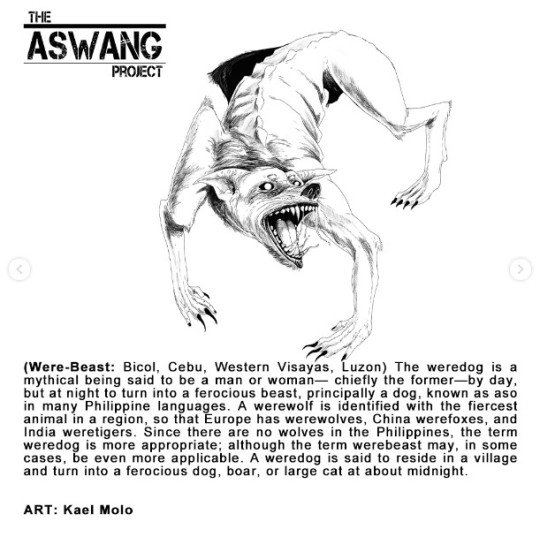
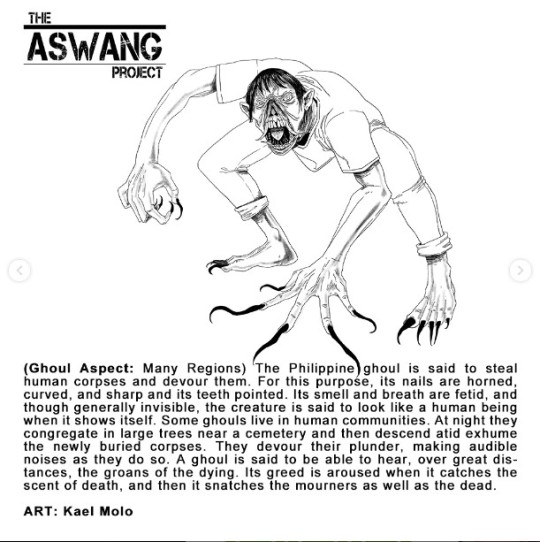
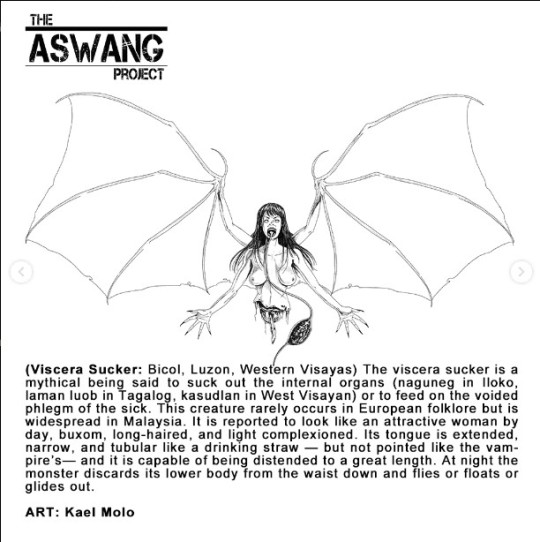

What is an aswang? This is a question that has continually resurfaced during my twenty years of studying the folklore and religious beliefs of the various ethnolinguistic groups in the Philippines. It is a question that so intrigued me, I spent almost five years exclusively exploring the topic, culminating in my documentary The Aswang Phenomenon (2011). It is a question that has confronted many before me, and will hopefully continue to intrigue academic and creative minds into the future. For the Filipino, the answer may seem very simple and concise. They will likely answer the question based on the belief in their community with such certainty and vigor that there is little room for misinterpretation. Moving to the next barangay will elicit a different yet equally assertive answer. Travelling throughout the country leaves one with hundreds of interpretations. In the 1960s, Dr. Maximo Ramos, affectionately referred to as the “Dean of Philippine Lower Mythology,” undertook the monumental task of creating taxonomical classification of folkloric beings throughout the Philippines. The culmination of this work was eventually published in a book called The Creatures of Philippine Lower Mythology (very recommended). Within its pages, folkloric creatures are neatly placed into twelve categories; Demons, Dragons, Dwarves, Elves, Ghouls, Giants, Merfolk, Ogres, Vampires, Viscera Suckers, Were beasts, and Witches. What I found curious was that the aswang appeared in five of these categories; Ghouls, Vampires, Viscera Suckers, Were beasts, and Witches. These became the taxonomic classification for the aswang in Ramos’ later work The Aswang Complex in Philippine Folklore (also recommended).
Ang ,ga larawan at impormasyon ay mula sa opisyal na Instagram account ng Aswag Project.
92 notes
·
View notes
Text

Smoking giants typically sat up in balete trees. If a kapre falls in love, they will follow said individual for the rest of their life, typically out of sight. Kapre are also said to carry small white stones, smaller than the egg of a quail. Should anyone manage to get ahold of this stone will be able to receive wishes from the kapre.
#BriefBestiary#bestiary#digital art#fantasy#folklore#legend#myth#mythology#kapre#tree giant#giant#spirit#tree spirit#filipino folklore#filipino legend#balete trees
16 notes
·
View notes
Text

Amihan, minor villain, design I got in a trade
#monster girl#aswang#manananggal#bat girl#bat wings#scar#filipina#cryptid#folklore#filipino folklore#vampire#vampire girl#sole survivor comic#oc#original character#monster#kaneidae art
13 notes
·
View notes
Note
Can you tell us more about Filipino mythology and moneters, cause there's no 1 official website and I almost always barely passed filipino? Can you also list like great sources for me to read? Thanks
I had a pretty busy week last week so it took a while to get to this ask but I'd love to give more info on the topic!
More on Filipino Mythology:
Si Apolaki at Mayari - Bakit may araw at gabi
EN: Apolaki and Mayari - Why there's day and night

An illustration of Apolaki and Mayari created by the illustrator PM Graphix
I am currently still doing a write-up on the Tagalog pantheon so I could start by maybe talking about that and what I've found. For the mythology section of this, let me start with something that's actually not from the Tagalog pantheon but is often attributed to the Tagalog pantheon: the Kapampangan story of Apolaki and Mayari or why the day and night exist. This story has been sourced from Maximo D. Ramos's book Philippine Myths, Legends, and Folktales (which you can buy on Amazon here, sadly I cannot find a free version of the book without going through suspicious links) and posted by Jordan Clark of The Aswang Project on his website.
BATHALA, the creator of the world, had a son named Apolaki and a daughter named Mayari. The light that shone upon the world and enabled the people, the beasts, the birds, and the fish to see came from the bright eyes of Apolaki and Mayari, So all the creatures loved them dearly. Bathala himself was very fond of his children, and he watched over them as they wandered across the meadows of heaven. Since the eyes of Apolaki and Mayari shone continuously, it was always day on the earth. In time Bathala grew feeble with age and died. Then Apolaki and Mayari had a quarrel, for each wanted to rule the world alone. “I am the man and I will succeed my father to the throne,” said Apolaki. “I am going to rule the world, whether you like it or not.” Mayari’s eyes flashed with anger and she said, “I am no less my father’s child than you. I will succeed him to his throne, whether you like it or not!” The quarrel grew from bad to worse, and finally words could not express their furious rage. So they picked up wooden clubs and fell upon each other with fierce blows. Back and forth they fought until at last Apolaki struck Mayari in the face and she became blind in one eye. When he saw his sister stricken, Apolaki took pity on her and said, “Let us fight no more, my sister. Let us share our father’s kingdom equally between us. Let us reign by turns and be friends.” Mayari agreed, and from then on, Apolaki, whom we know today as the Sun, has ruled the world half the time. Mayari, whom we now know as the Moon, has taken turns with her brother in ruling the world. When Apolaki is on the throne, the world is flooded with warm light, because the light beams from his two bright eyes. On the other hand, when Mayari is reigning, the world is bathed with cool and gentle light; for she is blind in one eye.
Now from what I've researched, a lot of places tend to attribute the story to the Tagalog people or state that it is a shared story from both the Tagalogs and their neighboring Kapampangan up north from them but I cannot find any specific source prior to the late 1960s that even mention that Mayari was part of the Tagalog pantheon so it may be a more recent addition.
The source that first states Mayari's inclusion as a part of the Tagalog Bathala's court comes from a paper written by F. Landa Jocano called Notes on Philippine Divinities (1968) where he does not cite a specific source of where he has learned Mayari was of Tagalog origin nor even stated that he had learned it from a Tagalog local and considering Jocano himself isn't a Tagalog nor is he Kapampangan, it's unlikely he's learned it from his upbringing or otherwise.
I had also done a little digging on his sources and none of them bring up Mayari nor her sister Hanan, the goddess of dawn, so the paper leaves much room for doubt. Tala, the goddess of stars, who is also listed in Jocano's paper make a lot more sense despite the lack of sources as it is the actual word for star in Tagalog but I still have to do further research on her as well.
Either way, I had also never heard of Mayari as a Tagalog deity outside Jocano's work and online articles that heavily source Jocano (The Aswang Project, one of the most popular sources for Filipino mythology which I had used as a specific source for Kapampangang mythology, has cited him twice in regards to Tagalog mythology specifically but not Kapampangan mythology). This is also despite me being born and raised within a mostly Tagalog community.
All of that for me to say that this story of Apolaki and Mayari may be a later addition to the Tagalog mythos after interests on Filipino mythology got revitalized from the mid-20th century onward rather than something that has always been a part of the Tagalog mythology.
Note that I'm not saying that it is an impossibility that this had been part of the Tagalog culture prior to that time period, but a lot of sources that discuss this do not bring up this story until after Jocano's work. I will have to maybe do more reading on this to find out more information about this and Mayari's status on whether or not she did belong to the Tagalog pantheon prior to the 60s.
I also want to add a quick note that it's pretty common for people to misattribute this story to the Pangasinense people as well but it may be from both people constantly confusing Pampanga from Pangasinan (think of it as how people confuse Sweden and Switzerland), as well as a name overlap with Apolaki who is referred to as Apolaqui in Pangasinan. The two places are both north of the Tagalog Regions. I might look into this connection/association/coincidence later on.
Further Readings and Sources
It's actually pretty hard to suggest a specific source for Filipino mythology given that a lot of them pull from the same reference (Notes on Philippine Divinities) which I had said has some dubious information but Maximo D. Ramos's book that I had referenced is a good read as it collects various myths from different places throughout the country. I myself had been thinking of getting a copy of the book soon as well as his other books.
Some Filipino Monsters
As for Filipino monsters, I could say that its similar with Filipino mythology, in that with so many cultures, there's many different kinds on who you're asking. These ghouls seem to be more widely similar from culture to culture, however, probably owing to the fact that the Catholic Church didn't discourage the belief in them as much as they did the precolonial gods. Whether you go to the northernmost part of the country to the southernmost islands, there is a lot of similarities between the creatures that they could be classified easier than the gods with some creatures even sharing traits from cryptids from other Southeast Asian countries.
I'll give some of them here that you may hear pretty often when looking through catalogues of Filipino monsters. I have to be honest that I may not source as much for this section since I will be bringing up some personal stories and anecdotes that are passed around the community. I'm also open to discuss more about these creatures as well as other monsters later on.
The Aswang
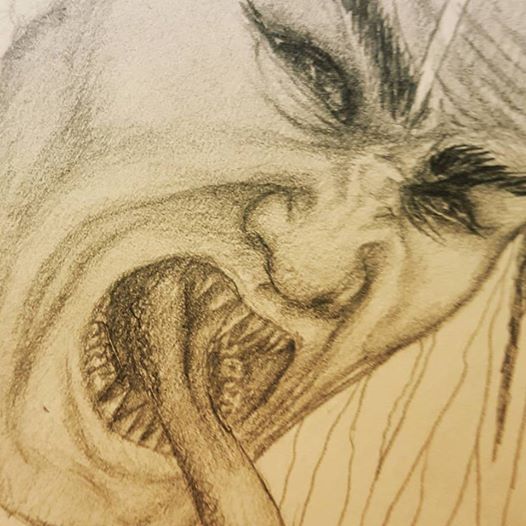
An artwork of an aswang uploaded to Wikipedia by H.M.Bec
Aswangs are often considered as the most ubiquitous of the Filipino monsters. When you look up monsters from the Philippines, this may be the top result. Aswangs are often portrayed as people who transform into ghoulish creatures that feast on human flesh but especially children, babies, and fetuses. There's so many stories and variations of aswangs, however, that some of the monsters in this list are actually sometimes considered as part of the aswang category depending on the source or who you ask.
Aswangs are shapeshifters, often turning into dogs, pigs, and many other creatures, in order to stalk their prey in the middle of the night.
Aswangs are also considered as one of the main stock monsters in FIlipino media so you may see them as the villains of a lot of fantasy series and movies. They're one of the villains that Alexandra Trese faces of regularly on the folklore-inspired supernatural comic book series turned Netflix original animation Trese. They're also the main antagonist in my favorite FIlipino fantaserye series Juan De La Cruz (although I don't particularly like the lead actor anymore lol).
Here's some stuff I've heard about Aswangs from those around me.
Aswangs often won't attack their neighbors and would rather attack neighboring villages/barangays/towns. This is so they avoid detection or suspicion from their community. So, if you suspect your neighbor's an aswang, then you might just be lucky they won't target you.
Aswangs are often said to have come from the province of Capiz. It's an often common joke and stereotype that Capizeños may be aswangs themselves or know people who are aswangs. The people of Capiz are mixed on how they feel about the association with the provincial government seemingly trying to shake off the specific association to their province.
They can go to mass but cannot stay during the consecration of the holy host. Holy water and holy [coconut] oil also boil in their presence.
When you look directly into their eyes, your reflection would be upside-down. They also don't have the dent between the nose and the lips.
They could pass their curse through different ways and may depend on belief or tradition. One belief states that if a person marries an aswang, they also become an aswang.
One of the other beliefs that can turn a person into an aswang is if one makes contact with an aswang's saliva.
According to another belief, a person could also become an aswang if they ingest a black chick alive.
Similarly, an aswang cannot die until they pass their curse to another person (typically a relative). This is done by passing a black stone or chick hidden in their body to the chosen new curse holder.
They hate the typical ghoulish hated items like holy crosses, water, oils, and the classic garlic and salt, but they also hate calamansi (a small Filipino citrus fruit), and my mother had always told me that they hate suha or pomelo (a type of citrus fruit) and the smell of burning rubber.
A typical weapon used to fight against them or ward them off is the buntot pagi or stingray tail that is often sold in occultic shops around the country. You could also buy this from online stores as I've learned (x)(x)(x).
Now here's a story I've heard about them:
A story I had heard was that of the aswang bus. I had heard it repeatedly throughout the years but the basic premise is that there's a bus of a bunch of aswangs from a different province that's traveling to [province you are in] and are hunting down people at night. This is some of the more funny stories about aswangs because I keep imagining an aswang bus driver purposefully running over people and then a bunch of aswang tourists hops off of the bus to drag the body for a snack later.
I honestly might come back to the aswangs topic later since I had just learned some things from a Capizeña who works to help around our house.
The Manananggal

An artwork of an aswang uploaded to Wikipedia by Gian Bernal
The Manananggal is a ghoulish creature and is often times categorized as a kind of aswang. They are typically humanoid creatures that appear as regular people (often women) during the day, but at night their torso severs from their legs and fly away with bat wings. They often feast on fetuses using their long proboscis tongue.
These ghouls share a lot of similarities with the Southeast Asian ghoul called the Penanggal which is a similar creature but instead of their torsos separating, their heads separate from their body alongside their entrails.
Manananggals are also some of the typical stock monsters in Filipino fantasy stories. I can't think of any specific instances of the manananggal being the main character besides the softer depiction of a manananggal girl named Anna in Dayo: Sa Mundo ng Elementalia who acts as a deuteragonist to the human boy Niko. They are also featured in Trese where a tribe of manananggal is shown. They are also the main lead or love interest in some horror movies and even horror romances.
Here's some stuff I've heard about Manananggals
It's name comes from the Tagalog word "tanggal" which means "to remove" or "to separate" and specifically means "the remover" or "the separator". This of course is a reference to the fact that it removes its torso from its legs or separates its body in half.
Unlike the typical aswang which transform back during daylight, the manananggal needs to find their way back to their body or else die by sunlight.
The unattached legs of the manananggal is their weakness. If found by a person, they only need to sprinkle salt or smear crushed garlic on the legs in order to destroy them.
A lot of the typical things that ward off the aswang are also typically effective towards the manananggal.
Similarly to the aswang, manananggals are also said to had come from Capiz.
The list is shorter because honestly, just take what most you've heard about the aswang and apply it here. I don't know specifically if things like the upside-down reflection or the lack of the dent between the nose and lips could apply to manananggals, however, and I don't think I've heard people claiming that about the manananggal.
Now here's a story I've heard about them:
One story I heard that I find quite funny was something my sister heard from one of her high school friends. This friend was struggling to fall asleep at night and was tossing and turning in bed when she heard bat-like fluttering from outside. She went out to inspect the source by looking out the window and was shocked to see a manananggal climbing up a coconut tree and seemingly harvesting the fruit in the middle of the night. She wasn't flying up the tree, she was climbing it.
The next day, an old woman who was selling her goods door-to-door came by their house. She was selling coconuts.
The Tiyanak
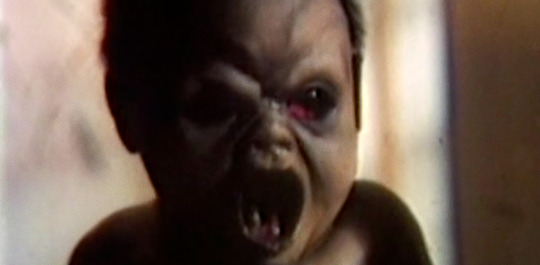
A screenshot of a tiyanak from the movie Tiyanak (1988)
The tiyanak is considered as a demonic baby that would transform itself into a regular looking baby, crying in the middle of the night in order to attract their unfortunate target who may feel pity towards the child. The tiyanak may also be classified as an aswang but is typically considered as a separate thing more often than the manananggal from my experience. This creature has noticeably a lot in common with a lot of other Southeast Asian and East Asian myths about demonic babies and toddlers like the tuyol or the tuyul.
Like the previous two, the tiyanak is also part of the typical stock monster antagonists found in Filipino media, but not as much as either the typical aswang or the manananggal. They are often used to add a bit of a scare factor into a story and isn't typically the main antagonist of a story as of recent horror movies (with only a single short B-Movie I could think of called Flight 666 from the Shake, Rattle & Roll horror anthology series. It is not a good movie but it's stupid fun). They are featured, as usual, in Trese as the main supernatural antagonists of a specific story arc. Their depiction from the comic and the Nteflix show has been changed due to the controversial nature of the comic book depiction.
When they appear in a horror series, there's often a sort of reason or lesson as to why one has appeared and typically based on the typical origins of the tiyanak.
The most common belief is that the tiyanak is the ghost or ghoulish corpse that had come from an unbaptized child.
At times, they may be a ghoulish baby that had been created after a woman gets an abortion, other times it is simply just a baby that had died before baptism often as a stillbirth or even as a joint death with their mother.
I had also heard that it may be an abandoned baby that had died to the elements.
It is also believed, the reason that they are cursed to wander the earth after death is because they were not given a name through baptism.
Because of this, when they typically appear in stories, it is often either a story about the bad that could come from abortion or child abandonment depending on the values of the writer.
The tiyanak would also sometimes lead people astray with its cries.
Speaking of its cries, there are some places that believe if the cry sounds loud and near, the tiyanak is actually farther away from you than if you hear the cries to be quieter and farther.
Here's a story I had heard about them:
A common Filipino story of the tiyanak is the parking lot story. Story goes that in certain parking lots of buildings, typically malls, you may hear a baby cry in the middle of the night when you're alone. This is a tiyanak that's trying to lure you in by seemingly tricking you into thinking that it is just an innocent abandoned baby which is sadly common in the country. It is common enough that there are some people who would often want someone to accompany them when they're alone in a parking lot at night.
Further Readings and Sources
As much as I had stated that The Aswangs Project and their handling of discussions about Filipino mythology, specifically Tagalog mythology, is dubious at best, they have a lot of good articles about aswangs that do align with local beliefs so reading through their website for monsters specifically could be a good and free resource. They had also made a documentary that you can watch for free on YouTube that covers a lot of this and more about aswangs.
For written works, I would suggest any of Maximo D. Ramos's works as I've brought up before. There's his published paper The Aswang Syncrasy in Philippine Folklore which is considered as basically the holy grail of Aswang research, which, as I had stated, take up a bulk of the FIlipino monsters. It's hard to find easily accessible PDFs of the paper and I remember that I found a copy of this or a similar work by Ramos but the link has eluded me.
For a less academic and more fun fictionalized source for Filipino monsters I suggest The Lost Journal of Alejandro Pardo: Meet the Dark Creatures from Philippines Mythology by Budjette Tan and David Hontiveros which is available through Amazon here. It follows a fictional researcher and his discoveries of Filipino monsters and other creatures. It's a pretty easy read with a lot of good information about cryptids and monsters from the Philippines, owing to it's style of found media. If you've seen something like Gravity Falls's officially published Journal 3 from the show's universe, it has a similar vibe to that.
That's all I have for now, but I am looking more into this topic! My PC has issues right now so I might answer questions more slowly than my already slow answering speed. I hope this post helped you learn a little more about Filipino mythology and cryptids.
#mayaposts#mayaqna#mayapino#filipino mythology#kapampangan mythology#tagalog mythology#filipino folklore#filipino monsters#bathala#apolaki#mayari#aswang#manananggal#tiyanak#long post#very long post#philippines#filipino
45 notes
·
View notes
Text
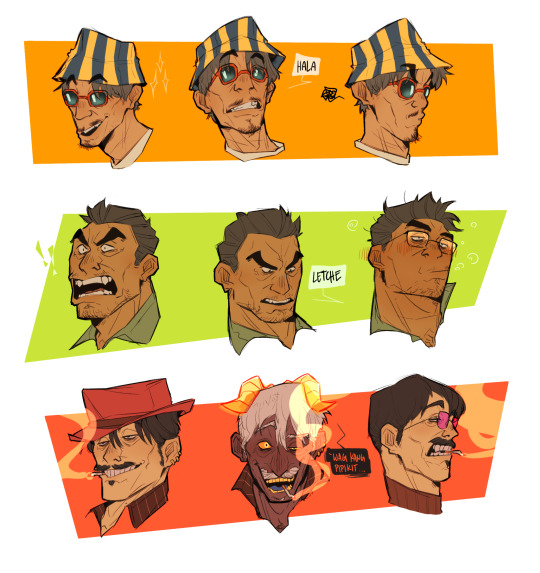
aha I've tricked you all into thinking I actually like disco elysium but I remove my mask and reveal that I'm actually more obsessed with my ocs have an expression sheet (/hj)
(i'll still post DE things along with oc things-)
Yeng, Ezekiel, and Paolo
#bazinga#oc#oc art#you can ask me anything about these guys btw#artists on tumblr#original character#original art#illustration#ocs#my ocs#oc story#filipino folklore
40 notes
·
View notes
Text
I was able to get the story from the woman who works for us who I will call Ka-J. and I had some interesting things come up from similar aswang stories I had read before. Here's some of the highlights of the story while I try to work on the transcript maybe for the next few days:
Aswangs could possess people and would often do so for selfish and even petty reasons. The possessed person was possessed for such a petty and miniscule reason that I'm honestly so perplexed. She possessed the woman because she... smelled good???? Like girl WHAT???? Just ask for her perfume brand or her laundry detergent brand holy shit
They fear holy items like crosses and rosaries. The possessed person from the story was cutting up rosaries and that's what primarily gave the aswang away.
The aswang could make the person's voice change. The possessed person was speaking at a strange tone extremely unfamiliar to her children.
The aswang may speak different languages, maybe unintelligible to the average person. I asked if it was in Latin or whatever stereotypical thing, but Ka-J said she could not determine that.
When the aswang was asked "Where did you come from? Above or below?", the aswang answered that she was "From below." implying that aswang do come from hell at least from this one incident.
The aswang exorcism didn't fully work the first time around so they had to do it twice. After the first instance, she was apparently worse.
They dislike calamansi which is something I've seen in some sources. This was done as an emergency way to freak out the aswang.
Folk healers could exorcise the aswang out of the person. Sometimes they may need the assistance of multiple healers. Ka-J. had told me that there were up to 7 to 8 healers during the final exorcism.
Some other interesting bits from the story that was told to me after or are things that seem just a little interesting to not add in but didn't fit the rest of the list:
The folk healers used an item she called "saway" (Note that Ka-J. is Bisaya but considering this takes place locally here, they probably call it a different name in the Tagalog region). She describes it as a brown (stick?) thing with a thorn attached. She says that there's a bit of gold on the item and when it pricks the aswang, the wound doesn't heal. I don't know what this item is, but it's similar to some stories I read where they would use certain tree branches or the buntot pagi (stingray tail) to injure the aswang.
The aswang was apprently a 50-year-old aswang woman. Very specific thing to have come from the exorcism. Besides that, she also gave her name and her "earth address" but Ka-J has forgotten what these were but it's probably pretty local.
One of the folk healers have a YouTube channel where he uploads the cases he handles. I had the displeasure of finding one of the videos and it is genuinely disturbing. It was just a woman crying but there was something eerie about it. I may not investigate further and I'm not going to link it here not only because of its disturbing nature, but this would essentially probably doxx me and I don't want these poor people's faces floating around because of my post.
I will try to get to actually transcribing + translating the short interview from the recording in maybe a couple of days. I think I may need to take a short break though since I feel a little uneasy after hearing and watching all that.
#filipinfodump#philippines#filipino#aswang#filipino folklore#filipino folk monsters#filipino monsters#filipino witchcraft#filipino aswang#folk healers#folk healing#folk monsters#witchcraft#exorcism#albularyo#possession tw#demon tw#mod maya
11 notes
·
View notes
Text

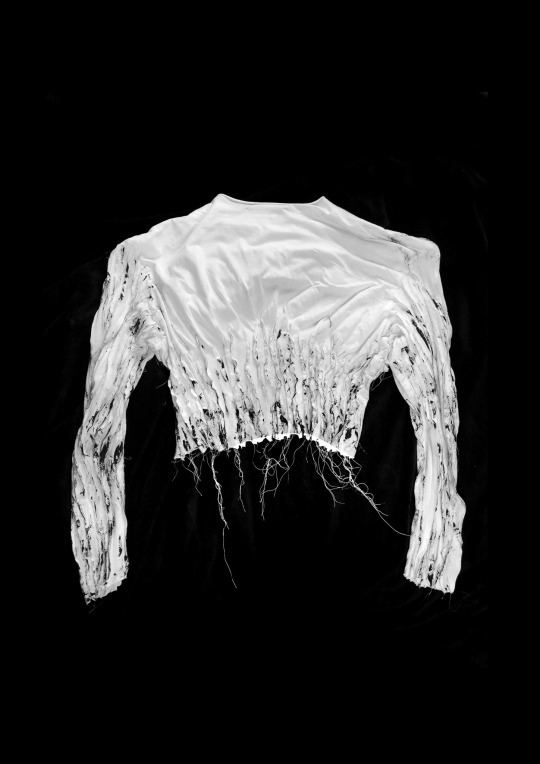
“Aswang Skin” (long sleeve) by Jean Louie Castillo Fashion collection “FEAR CESSATION” 2021-2.
This garment was designed with the intention of embodying the idea of ‘fear’ through the exploration of Filipino folklore’s Aswang phenomenon: the a shapeshifter or personification of fear. The designing period of FEAR CESSATION involved in-depth introspective views on what it means to feel ‘fear’, so I plagued my research with personal phobias and things that made my skin crawl.
-
The most debilitating phobia of mine is Trypophobia, clusters of holes and stripes. Groups of natural-looking, minuscule hell holes. I have never understood why this affects me so appallingly. Just thinking of it makes me unwell and want to scream. I’m sure many others feel the same way. I thought that by the end of project FEAR CESSATION, my phobia would cease or at least neutralise - I was wrong.
-
The Aswang Skin Long Sleeve is a beautiful outcome from such an unspeakable phobia. The garment doesn’t not nauseate me for some reason - perhaps it’s that I’m the one who made it and I know it can’t hurt nor infect me. All my life I’ve been scared of acquiring deathly infections with holes and lumps on the surface of my skin. Dermatitis is bearable but still not something I need or want on my body. (Research reference: Sick Rose by Richard Barnett, Thames & Hudson). Fatal bacteria and germs that inhabit these clusters of holes and lumps are my idea of literal hell. This is a personal phobia I’ve dealt with my entire life and it doesn’t seem to go away; constant hand sanitisation, mask wearing and avoidance of skin to skin contact with strangers still isn’t enough for me. I want to swim in concentrated bleach to know that I’m pure and thoroughly sterilised.
With this garment, I’ve managed to become a philocalist of trypophobia… (only for a second) if you look past the revolting clusters and the logical meaning that there are millions of deadly inhabitants writhing inside, then you’ll see the beauty in repetition of lines, circles and dots in textile form. The stretch cotton long sleeve has pintucks (fabric manipulation) on the sleeves and torso, the worst places to be infected, if so, with black fabric paint to enhance the trypophobia appearance. If you’re a fashion fan, you’ll see the Margiela reference through the silhouette (Martin Margiela, Sock Sweater, AW91). This piece, stylistically, is a heavy nod and a love letter Martin Margiela (my saviour).
#aswang#fear#sick rose#scary stories#scary#horror#creepy#folklore#filipino#filipino folklore#night time#martin margiela#margiela#maison margiela#90s fashion#menswear#mensfashion#fashion designer#fashion#designer#runway#jeanlouiecastillo#nightmares#goth fashion
24 notes
·
View notes
Text
tbh calling aswangs especially the manananggal "vampires" really downplays how horrifying they really are imo
they don't just drink blood. theyre monsters that shapeshift into normal humans at daytime. they eat people, even babies. or they just kill you.
that's a generalization but you get the point
#its pretty much just foreigners calling them vampires#i dont actually mind it when u bring up these monsters when talking about vampires from other cultures#but it just downplays how scary they are imo#aswang#manananggal#opinion#my opinion#filipino folklore#filipino mythology#filipino mythical creatures#monsters#vampire#does the manananggal count as an aswang? i dont remember
55 notes
·
View notes
Text





@japhers' sweet and spicy old man romance
🍰🫀DONE DEAL 🫀🍰
will only be available if we hit our funding goal!
Two well-established bakers and business partners reminisce on a pact they'd made when they were much younger.
A romance between a human and sigbin baker!
Support us and get this comic made! Only 9 days to go!
We've even got an adorable Sigbin Baker wooden keychain as one of our add-ons!

Keychain designed by Meg ✨
#sigbin#filipino monster#filipino folklore#japhers#old man yaoi#old man romance#monster romance#monster lover#monster x human
434 notes
·
View notes
Text

Monster Challenge 🦇🩸
so I decided to do this trend LMAO. sorry if my edits ain't good
so what is a Manananggal ?
The word manananggal comes from the Tagalog word tanggal, which means "to remove" or "to separate", which literally translates as "remover" or "separator". In this case, "one who separates itself". The name also originates from an expression used for a severed torso. The manananggal is described as scary, often hideous, usually depicted as female, and always capable of severing its upper torso with its intestines trailing out and sprouting huge bat-like wings to fly into the night in search of its victims.
The manananggal is said to favor preying on sleeping, pregnant women, using an elongated proboscis-like tongue to suck out fetuses, or the blood of someone who is sleeping. It also haunts newlyweds or couples in love and sometimes newborn children. Due to being left at the altar, grooms-to-be are one of its main targets.[1] The severed lower torso is left standing, and is the more vulnerable of the two halves. Sprinkling salt, smearing crushed garlic, lighting it on fire, or smearing ash on top of the standing torso is fatal to the creature. The upper torso then would not be able to rejoin itself and would perish by sunrise.
(https://en.m.wikipedia.org/wiki/Manananggal)
#spooky month#filipino folklore#aswang#manananggal#digital artist#my art lmao#monster#cw: gore#artists on tumblr#idk lmao#spooky
6 notes
·
View notes
Text

Uno Morales, artist
8 notes
·
View notes
Text

Happy late Mermay! I do hope this beautiful artwork of a sirena makes up for it!
2 notes
·
View notes
Text
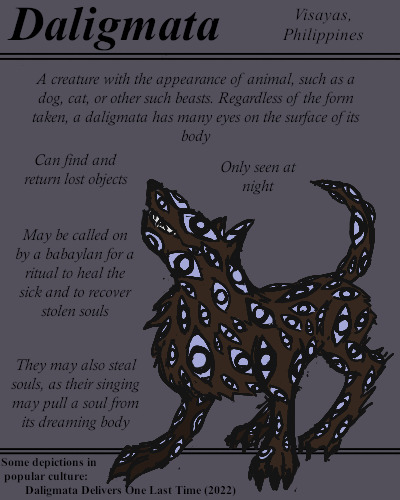
Many-eyed nocturnal beasts. They appear to be primarily benevolent, despite the occasional description of soul-thievery.
#BriefBestiary#bestiary#digital art#fantasy#folklore#legend#daligmata#beast#spirit#soul stealer#filipino folklore#filipino legend#visayas#visayan folklore#visayan legend
19 notes
·
View notes
Text
Buso

Image © Paizo Publishing, accessed at Archives of Nethys here
[The buso are a category of monsters in the folklore of the Bagobo people of the Philippines. “Buso” is one of those words that covers a lot of territory, like “aswang” or “bakemono”. Or, to be honest, “goblin”, “elf” or “dragon”. Some authentic busos do have one eye and man-eating habits, so this interpretation works for me. ]
Buso CR 3 NE Humanoid This humanoid is tall and gangly. It has a single oversized eye, small sharp teeth, and an upturned chin. Their hair is like the vines of a creeper, thick and studded with small leaves.
The buso are humanoids native to warm seasonal forests, who are required by a quirk in their physiology to consume the flesh of other humanoids on a regular basis. A buso who goes without a meal of humanoid flesh for a month becomes sickly, and will die before the year is out. Thus, buso are feared and hated by most other peoples, although they get along well with goblinoids (who are similarly omnivorous and callous). The buso attribute this hunger, their single eyes, and their ability to control plant life to the intervention of forest spirits called busaw. Most of a buso’s diet comes from agriculture—they grow fruits, tubers and herbs in forest gardens watched over by an elevated guard house.
Because of their knowledge of plants and abilities to cause plants to grow abnormally large, buso are sometimes sought out by people experiencing a famine. The buso are happy to trade with these people, granting them expertise or magical assistance in exchange for better weapons and armor. Communities that trade with the buso are not necessarily immune to their depredations, but may become so with occasional sacrifices (particularly of travelers, prisoners and other undesirables). Buso advance by character class; druid and ranger are common choices, as are barbarians and fighters.
Buso Datu On rare occasions, a busaw spirit may decide to inhabit the body of a baby buso. The resultant combination is called a buso datu by the buso, and usually advances to a position of authority and respect, if not taking over their community as headman. A buso datu has two eyes, an ivory horn on the top of its head and power over fire. A buso datu is treated as a buso with the advanced simple template and the following spell-like abilities at CL 4th: burning hands and produce fire 3/day; pyrotechnics and resist energy (fire only) 1/day (Wisdom based save DCs). A buso datu is a CR 4 creature.
Buso CR 3 XP 800 NE Medium humanoid Init +1; Senses low-light vision, Perception +8 Defense AC 14, touch 11, flat-footed 13 (+1 Dex, +1 natural, +2 armor) hp 30 (4d8+12) Fort +3, Ref +5, Will +2 Offense Speed 30 ft. Melee masterwork kukri +8 (1d4+4/18-20), bite +2 (1d3+2) or bite +7 (1d3+4) Ranged javelin +4 (1d6+4) Special Abilities resize plant Statistics Str 18, Dex 13, Con 15, Int 16, Wis 12, Cha 9 Base Atk +3; CMB +7; CMD 18 Feats Nimble Moves, Toughness Skills Climb +14, Knowledge (arcana) +7, Knowledge (nature) +7, Perception +8, Profession (cook) +7, Survival +7; Racial Modifiers +4 Climb, +4 Perception Languages Goblin, Sylvan Ecology Environment warm forests Organization solitary, pair, party (3-8) or community (9-24 plus 1-4 buso rangers of 2nd-5th level and 0-1 buso datu) Treasure standard (leather armor, masterwork kukri, 3 javelins, other treasure) Special Abilities Resize Plant (Su) Three times per day as a standard action, a buso can touch a mundane plant or plant creature and adjust its size. For a mundane plant, the plant changes size within 1 category. For a plant creature, this functions as an enlarge person or reduce person spell (CL 4th, DC 14 negates), except that it only affects plant creatures. The save DC is Constitution based.
48 notes
·
View notes